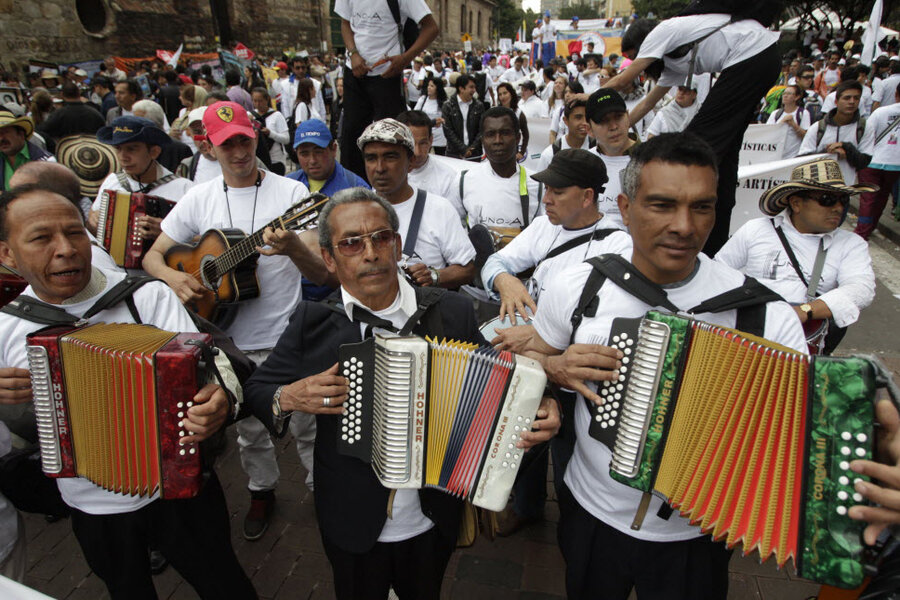Tens of thousands march for peace in Colombia after decades of conflict
Loading...
| Bogotá, Colombia
Tens of thousands of Colombians marched through the streets of Bogotá today in a mass demonstration of solidarity with victims of Colombia’s half-century-old conflict, and in support of the peace negotiations aimed at ending it.
President Juan Manuel Santos, who joined the colorful march after speaking to soldiers at the monument of fallen heroes, said the demonstrations “in favor of the victims … will accelerate, I’m certain, the achievement of peace.”
At noon, church bells rang throughout the country in remembrance of the victims of the conflict, which include an estimated 70,000 dead, as many as 50,000 disappeared, and more than four million internal refugees.
Farmer Miguel Anzola said he just recently joined the ranks of the displaced. He was driven from his farm in the southern province of Meta to the Colombian capital last August after receiving death threats. He marched wearing a white t-shirt and waving a white flag.
“We’ve got to stop this war of Colombians against Colombians,” Mr. Anzola says, adding that his hope is that the government and rebels of the Revolutionary Armed Forces of Colombia (FARC) can reach a peace deal so that he can recover what he’s lost.
The government and FARC launched peace talks in November and have been holding negotiations in Havana. This week the FARC reinforced its negotiation team with senior leader Pablo Catatumbo, a member of the group’s seven-man ruling secretariat.
'Clamor for peace'
But even as thousands of Colombians marched to remember the victims, Ever Cordero, a peace activist in Cordoba Province, was gunned down by unknown assailants, an act that President Santos condemned in a tweet. The murder followed a string of deaths last month of some of the march organizers.
Like many of those marching today, Merado Zambrano’s transportation to Bogotá was organized by the leftist Marcha Patriótica political movement. It's a group that brings together peasant farmers, union members, and leftist politicians. Mr. Zambrano says he traveled to Bogotá by bus from Poapyán, in southwestern Colombia, to join the peace marches and show his support for the peace process. “We are tired of war. Peace is our only hope.”
Military intelligence says the Marcha Patrótica is financed by the FARC, which the group denies.
In a video statement from Havana, Mr. Catatumbo welcomed the marches, calling them “a great clamor for peace; we join the great national mobilizations without waver.”
'A single day of peace'
April 9 is a significant date in the history of Colombia's present-day conflict. It marks the anniversary of the 1948 assassination of populist politician Jorge Eliécer Gaitán, who was running for president. His death sparked a 10-year period of partisan violence known simply as La Violencia. Many historians trace the roots of today’s conflict and the FARC rebels to that time.
In a televised speech Monday night, Santos said Mr. Gaitán’s murder “was a dark moment that began a period of violence that has not yet ended. Neither my generation or that of our children has enjoyed a single day of peace.”
Addressing critics of his decision to negotiate with the FARC, which the United States and Europe have label a terrorist group, Santos said that some Colombians “remain trapped in the past, clinging to a vision of Colombia condemned to violence.
“Peace should not divide us,” he said.
Critics – including former President Alvaro Uribe, under whose presidency from 2002 to 2008 the FARC was severely weakened – say Santos is offering the rebels exemption from punishment in exchange for laying down their arms. Santos says such an agreement has not been discussed during peace talks. Mr. Uribe said he is opposed “not to peace but to peace with impunity.”
Packed into Bogotá’s Bolivar Square demonstrators chanted that those who want peace outweigh the critics. “We are more! Peace now!” they cried.







